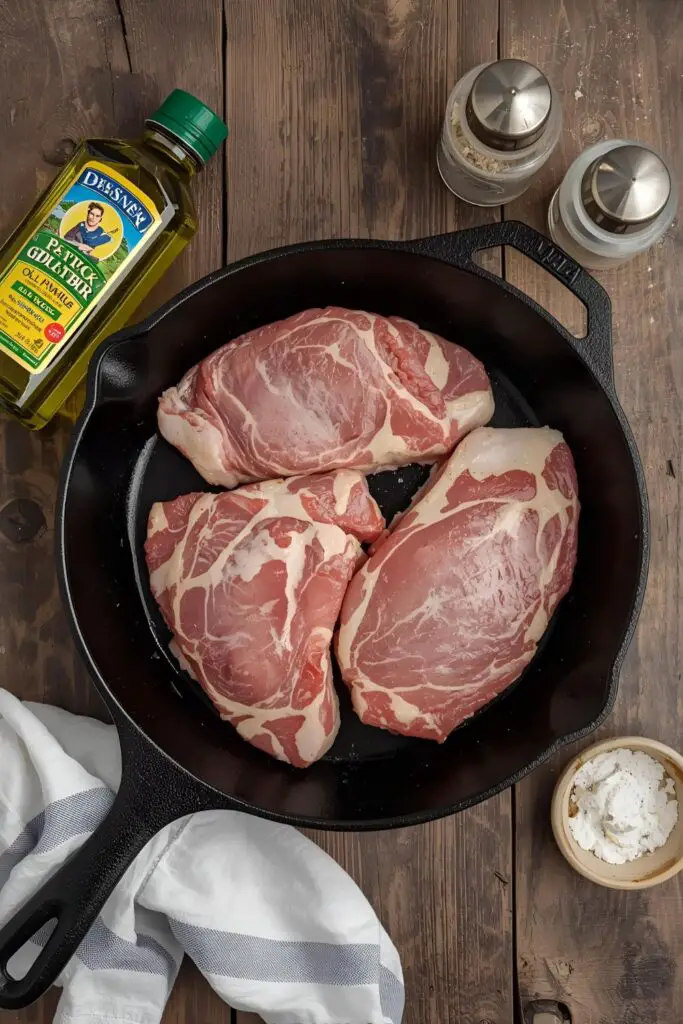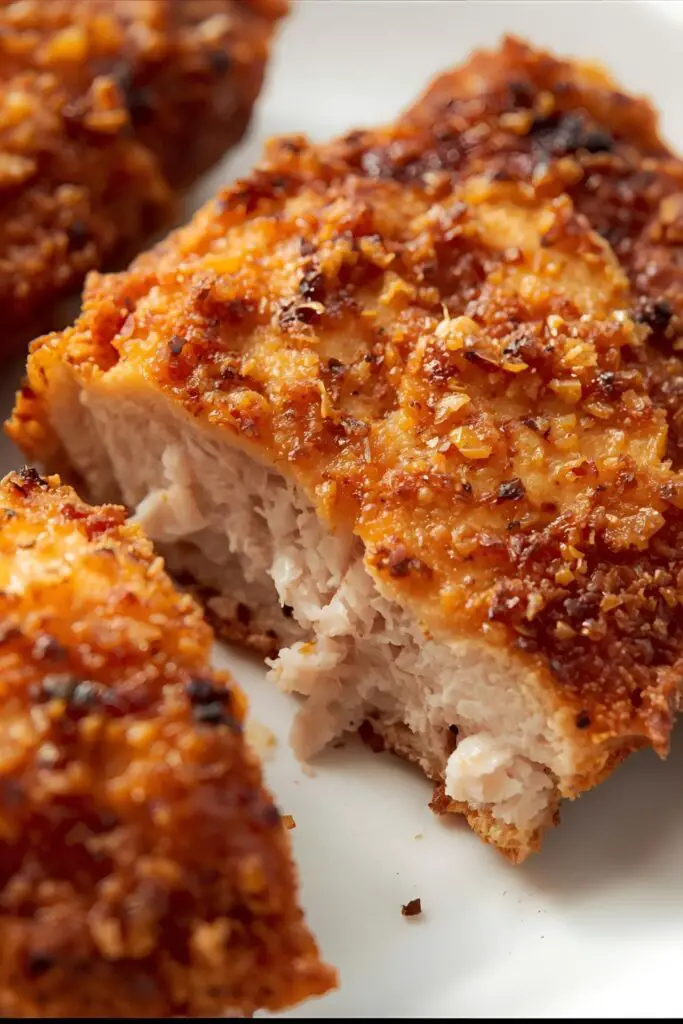How to Fry Pork Chops in a Skillet: The No-Fuss Guide to Crispy, Juicy Perfection
Let’s be real. Sometimes you just need a good, solid piece of meat. And when that craving hits, few things satisfy quite like a perfectly fried pork chop. Forget those dry, hockey-puck excuses for pork. We’re talking about golden-brown, crispy edges giving way to tender, juicy meat that makes you want to do a little happy dance. If you’ve ever wondered how to fry pork chops in a skillet and get restaurant-quality results without the fuss, then buckle up, buttercup. You’ve come to the right place.
Why This Skillet-Fried Pork Chop Recipe is Officially Awesome
Why bother firing up the skillet for pork chops? Because, my friend, it’s the express lane to flavor town. Pan-frying gives you that glorious crispy crust that’s just plain addictive, while the inside stays wonderfully moist and tender. No fancy techniques, no complicated marinades (unless you’re feeling frisky, which we’ll get to).
This recipe is all about simplicity and speed. You can have perfectly cooked pork chops on the table faster than you can say “Where’s the gravy?” (Spoiler alert: we’ll talk about gravy too). It’s a weeknight dinner superhero, a crowd-pleaser, and proof that you don’t need to be a culinary genius to make seriously good food. Plus, the sound of those chops sizzling in the pan? ASMR for food lovers, IMO.
The Pork Chop Ingredient Lineup
Here’s what you’ll need to transform those humble pork chops into a culinary triumph. Keep it simple, keep it tasty.
- 2-4 bone-in or boneless pork chops: About 1-inch thick is ideal. Thicker chops will take longer to cook. Choose your weapon – bone-in generally have more flavor, but boneless cook a bit faster.
- 1 tablespoon olive oil or vegetable oil: For searing those beauties.
- 1 tablespoon butter: Because butter makes everything better. Don’t even try to argue.
- Salt and freshly ground black pepper: The dynamic duo of seasoning. Don’t skimp!
- Optional Flavor Boosters (pick one or mix & match):
- 1 teaspoon garlic powder
- 1 teaspoon onion powder
- 1/2 teaspoon smoked paprika
- 1/2 teaspoon dried thyme or rosemary
Key Substitutions:
- Oil: You can use other high-heat oils like canola or avocado oil.
- Butter: If you’re dairy-free, you can use more oil, but the butter adds a richness that’s hard to beat.
- Spices: Feel free to get creative with your spice blend! Cajun seasoning, Italian herbs, or even a pinch of red pepper flakes can add a fun twist.
Tools & Kitchen Gadgets You’ll Need
You won’t need a whole arsenal of kitchen gadgets for this, thankfully.
- Large skillet (preferably cast iron): Cast iron is your best friend for even heat distribution and a killer crust. But any heavy-bottomed skillet will work.
- Tongs: For flipping the pork chops safely and easily.
- Paper towels: For patting the pork chops dry (trust me, this is important!).
- Meat thermometer: Your secret weapon for perfectly cooked pork. Seriously, get one if you don’t have one.
- Plate: To rest the pork chops after cooking.
Let’s Get Frying: Your Step-by-Step Guide to Pork Chop Nirvana
Alright, let’s get down to business. Follow these steps, and you’ll be biting into juicy, flavorful pork chops in no time.
Step 1: Prep Those Chops (Dry is Your Friend!)
- Take your pork chops out of the refrigerator about 15-20 minutes before cooking. This helps them cook more evenly.
- Pat the pork chops completely dry with paper towels. This is crucial for getting a good sear. Excess moisture will steam the chops instead of frying them. Trust me on this one.
- Season both sides of the pork chops generously with salt and freshly ground black pepper. If you’re using any other spices, sprinkle them on now as well, pressing them lightly into the meat.
Step 2: Heat Up the Skillet (Patience, Grasshopper)
- Place your skillet over medium-high heat. Let it get nice and hot. How do you know it’s ready? Flick a tiny drop of water into the pan – it should sizzle and evaporate almost immediately.
- Add the olive oil (or vegetable oil) to the hot skillet and swirl it around to coat the bottom.
- Now, add the butter. It should melt quickly and start to sizzle gently. The combination of oil and butter helps prevent the butter from burning while still providing that delicious flavor.
Step 3: The Sizzle Show (Don’t Crowd the Pan!)
- Carefully place the seasoned pork chops in the hot skillet. Make sure you don’t overcrowd the pan. If you try to cram too many chops in, they’ll lower the temperature of the skillet and steam instead of sear. Cook in batches if necessary.
- Let the pork chops sear undisturbed for 4-5 minutes on the first side. You’re looking for a beautiful golden-brown crust. Resist the urge to peek and poke! Trust the process.
- Flip the pork chops using your tongs and cook for another 3-5 minutes on the other side, until they are golden brown and cooked through.
Step 4: Check for Doneness (Safety First, Flavor Second… Wait, Both!)
- The cooking time will vary depending on the thickness of your pork chops. The best way to ensure they’re cooked perfectly is to use a meat thermometer.
- Insert the thermometer into the thickest part of the pork chop, avoiding any bone.
- The internal temperature should reach 145°F (63°C) for safe consumption, according to the USDA.
- Don’t overcook them! Overcooked pork chops are dry and sad. Aim for that perfect 145°F and remove them from the heat.
Step 5: Rest is Best (Seriously, Don’t Skip This!)
- Once the pork chops are cooked, transfer them to a clean plate and let them rest for 5-10 minutes before slicing or serving.
- During this resting time, the juices redistribute throughout the meat, resulting in a much more tender and flavorful chop. If you skip this step, all those lovely juices will run out when you cut into them, leaving you with a drier chop.
Step 6: Serve and Enjoy (You Deserve It!)
Serve your perfectly fried pork chops immediately with your favorite sides. Mashed potatoes and gravy? Roasted vegetables? A simple salad? The possibilities are endless. Pat yourself on the back – you just made some seriously good food!
Calories & Nutritional Info (Approx. per 4oz serving of cooked boneless chop)
- Calories: 200-250
- Protein: 30-35g
- Fat: 8-12g
- Saturated Fat: 3-5g
- Sodium: Varies depending on seasoning
Nutritional Note: Pork is a good source of protein and several important vitamins and minerals. However, it can also be high in saturated fat, so enjoy in moderation as part of a balanced diet.
Common Mistakes to Avoid (Don’t Be a Pork Chop Tragedy)
- Frying Cold Pork Chops: This leads to uneven cooking. The outside will cook too quickly while the inside stays cold. Let them sit at room temperature for a bit.
- Not Drying the Pork Chops: We can’t stress this enough! Moisture is the enemy of a crispy crust. Pat them dry like you mean it.
- A Cold Skillet: If your skillet isn’t hot enough, the pork chops will steam instead of sear. Be patient and let it heat up properly.
- Overcrowding the Pan: We mentioned this, but it’s worth repeating. Give those chops some personal space!
- Constantly Flipping: Let them develop a good crust on each side before you even think about flipping them. Trust the sizzle.
- Overcooking: Dry, tough pork chops are a sad state of affairs. Use a meat thermometer! It’s a game-changer.
- Skipping the Resting Time: We know you’re hungry, but that short rest makes a huge difference in the juiciness of your pork chops. Be patient just a little longer.
Variations & Customizations (Spice Up Your Chop Life!)
- Breaded Pork Chops: For an extra crispy coating, dredge your pork chops in seasoned flour, then an egg wash, and finally breadcrumbs (panko works great!). Fry as directed, but they might take a little longer to cook through.
- Garlic Herb Butter Pork Chops: After searing, add a few cloves of smashed garlic and some sprigs of fresh thyme or rosemary to the pan along with the butter. As the butter melts, spoon it over the pork chops for extra flavor.
- Spicy Chili-Lime Pork Chops: Before cooking, rub your pork chops with a mixture of chili powder, cumin, garlic powder, onion powder, and a pinch of cayenne pepper. Finish with a squeeze of fresh lime juice after cooking for a bright, zesty kick.
FAQ Section: Your Pork Chop Ponderings, Answered.
- What kind of skillet is best for frying pork chops? A heavy-bottomed skillet, especially cast iron, is ideal for even heat distribution and a great sear.
- Should I use bone-in or boneless pork chops? Either works! Bone-in tend to be more flavorful and stay juicier, but boneless cook faster. Adjust cooking time accordingly.
- How long do you fry 1-inch thick pork chops? About 3-5 minutes per side over medium-high heat, until they reach an internal temperature of 145°F (63°C).
- Can I fry frozen pork chops? It’s not recommended, as they won’t cook evenly. Always thaw them completely before frying.
- What temperature should the oil be for frying pork chops? Aim for around 300-325°F (150-160°C). If the oil is smoking, it’s too hot.
- How do you make gravy from the pan drippings? After removing the pork chops, keep the pan over medium heat. Whisk in a tablespoon or two of flour and cook for a minute. Gradually whisk in some chicken broth (or water) until the gravy thickens. Season to taste.
- What are some good side dishes for fried pork chops? Mashed potatoes, roasted vegetables, coleslaw, green beans, mac and cheese – the possibilities are endless!
Final Thoughts: Go Forth and Fry Fearlessly!
Well, there you have it. You are now officially equipped with the knowledge to conquer the skillet and fry up some seriously amazing pork chops. So ditch the takeout menus, grab some chops, and get cooking! You’ll be amazed at how easy it is to create a delicious and satisfying meal. Now, if you’ll excuse me, I hear some pork chops calling my name. Happy frying! 🙂



